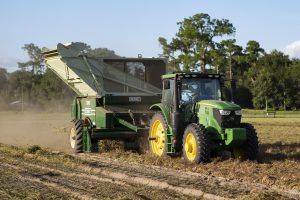Dangers lurk for those working in agriculture – an economic sector that includes farms, forestry, fisheries and hunting.
When you combine agriculture, forestry and fishing, 18,750 people suffered nonfatal injuries in 2020 in the United States. That’s up from 16,280 in 2010, according the federal Bureau of Labor Statistics.
As we near National Farm Safety and Health Week (September 18-24), we talked to Serap Gorucu, a UF/IFAS assistant professor of agricultural and biological engineering. We asked Gorucu, author of a new UF/IFAS Extension document, to explain the dangers of jobs in the agricultural sector and some ways to help those working on farms to stay as safe as possible.

Q: What are the most common injuries in the agricultural sector and why?
A: Almost half of agricultural fatalities result from vehicle-related incidents. Agricultural vehicles on work sites and roads create risks for the operators, employees working nearby and occupants of other vehicles who share the road.
Oftentimes, injuries also can result from falls — whether from equipment or elevated surfaces.
Additionally, farmworkers – for example, those who harvest tomatoes or watermelons — can hurt themselves or get sick through overexertion from lifting, pushing, pulling or repetitive motions.
Equipment-related injuries are also common.
Q: What are the most dangerous aspects of working on a farm and why?
A: Working in the agricultural sector can be hazardous for several reasons:
- If you’re a farmer, your workplace is often your home, with machines and other worksite hazards practically everywhere on the property.
- You’re working outside, sometimes under extreme weather conditions. Outdoor workers are exposed to many environmental conditions such as temperature extremes — heat or cold, lightning, sun and more. Even though the Occupational Safety and Health Administration (OSHA) has no standard for heat safety for outdoor workers, employers should provide safe conditions for their workers. That includes providing training, shade, water and rest time to prevent these illnesses.
- Young children and aging people often work on farms. Even if they’re not working at the farm, children could be at risk merely by being present. In the United States, a child dies in an agricultural-related incident about every three days. Almost two-thirds of these fatalities are children who are not working but might be a bystander or a passenger in an agricultural vehicle. By comparison, aging farmers are susceptible to many injuries resulting from falls or injuries related to machinery or tractors.
Q: Why should workplace safety be important to farmers, farm managers and farmworkers?
A: Most of the time, businesspeople look at productivity and focus on getting the work done. However, they must make sure they’re following safe practices to help avoid the cost of injuries and lost days.
In agriculture, farmers must complete certain tasks in a timely manner. An unexpected injury to an employee can affect the completion of the work. So, improving safety affects productivity and also the quality of work.
If they follow safety protocols and written safety plans — while they are providing a safe workplace for individuals — they also increase their productivity.

Q: What are a few suggestions to make the agricultural sector a safer place to work?
A: Employers should provide periodic agricultural safety and health trainings. Even experienced farmers or farmworkers might get injured. That’s why refresher safety training should be offered as often as possible. Also, remember to provide these trainings to all workers. For example, most of the time, safety trainings are provided for tractor operators. They need to check their surroundings for possible hazards and the presence of other employees nearby. Business owners should also train other employees who are working near, or next to, heavy machinery to prevent potential injuries or deaths.
It is also important to keep equipment and vehicles well maintained and inspect them before operating.
When moving agricultural equipment/vehicles on roadways make sure you use proper marking and lighting. This improves the visibility of farm vehicles on roadways and can prevent accidents.
Finally, OSHA provides standards and recommendations for such areas as guarding farm field equipment, protecting against rollover accidents and for avoiding heat exposure.
###
ABOUT UF/IFAS
The mission of the University of Florida Institute of Food and Agricultural Sciences (UF/IFAS) is to develop knowledge relevant to agricultural, human and natural resources and to make that knowledge available to sustain and enhance the quality of human life. With more than a dozen research facilities, 67 county Extension offices, and award-winning students and faculty in the UF College of Agricultural and Life Sciences, UF/IFAS brings science-based solutions to the state’s agricultural and natural resources industries, and all Florida residents.
 1
1
